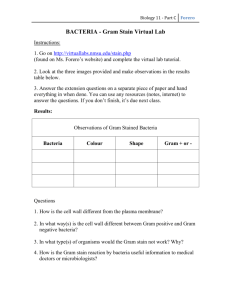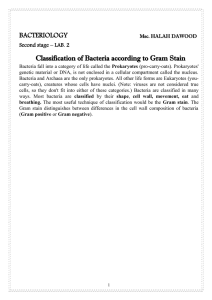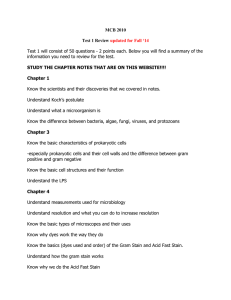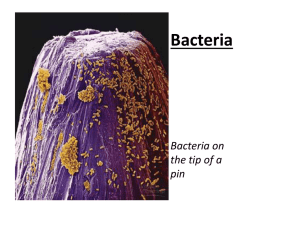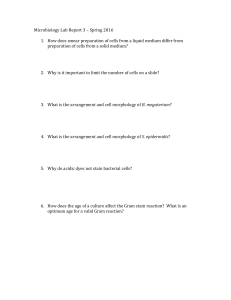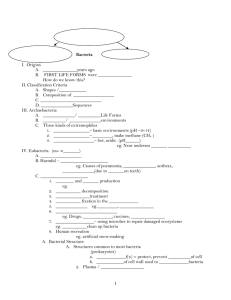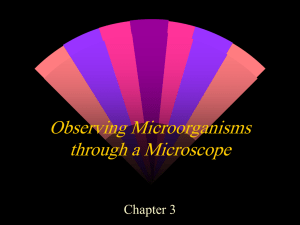Study Guide for Microbiology (BIO 6) Lab Exam 1
advertisement
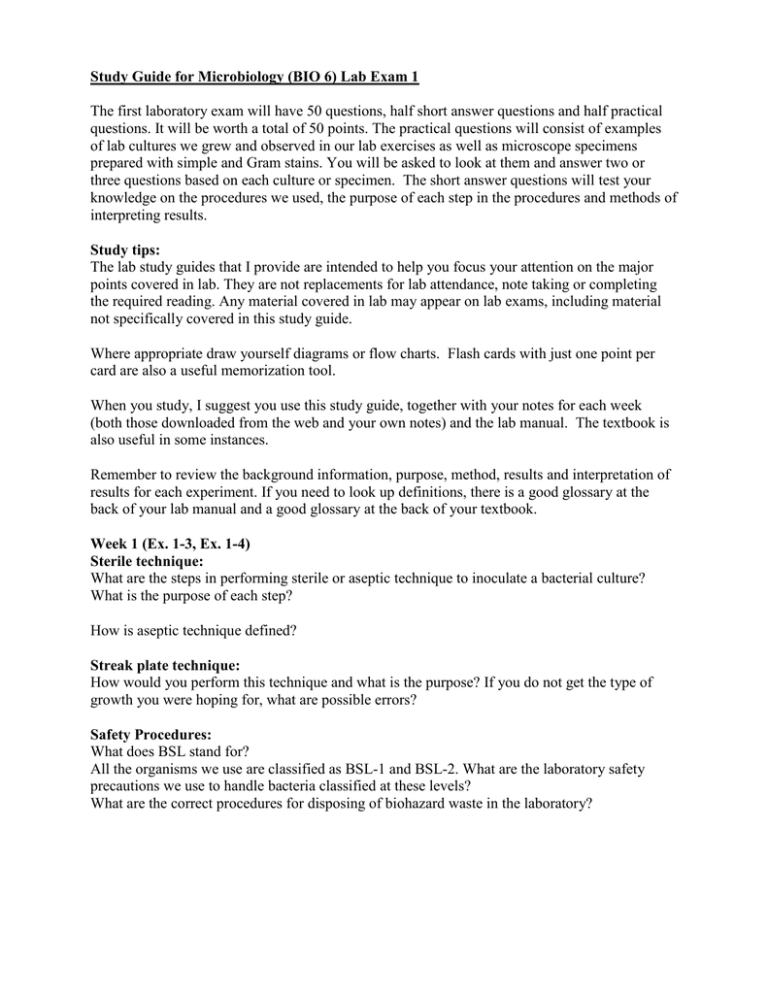
Study Guide for Microbiology (BIO 6) Lab Exam 1 The first laboratory exam will have 50 questions, half short answer questions and half practical questions. It will be worth a total of 50 points. The practical questions will consist of examples of lab cultures we grew and observed in our lab exercises as well as microscope specimens prepared with simple and Gram stains. You will be asked to look at them and answer two or three questions based on each culture or specimen. The short answer questions will test your knowledge on the procedures we used, the purpose of each step in the procedures and methods of interpreting results. Study tips: The lab study guides that I provide are intended to help you focus your attention on the major points covered in lab. They are not replacements for lab attendance, note taking or completing the required reading. Any material covered in lab may appear on lab exams, including material not specifically covered in this study guide. Where appropriate draw yourself diagrams or flow charts. Flash cards with just one point per card are also a useful memorization tool. When you study, I suggest you use this study guide, together with your notes for each week (both those downloaded from the web and your own notes) and the lab manual. The textbook is also useful in some instances. Remember to review the background information, purpose, method, results and interpretation of results for each experiment. If you need to look up definitions, there is a good glossary at the back of your lab manual and a good glossary at the back of your textbook. Week 1 (Ex. 1-3, Ex. 1-4) Sterile technique: What are the steps in performing sterile or aseptic technique to inoculate a bacterial culture? What is the purpose of each step? How is aseptic technique defined? Streak plate technique: How would you perform this technique and what is the purpose? If you do not get the type of growth you were hoping for, what are possible errors? Safety Procedures: What does BSL stand for? All the organisms we use are classified as BSL-1 and BSL-2. What are the laboratory safety precautions we use to handle bacteria classified at these levels? What are the correct procedures for disposing of biohazard waste in the laboratory? Week 2 (Ex. 2-2, 2-3, 2-4) Know the terminology used to describe cultural characteristics of plates, broths and slants. Focus on the terms you were given during the lab introduction. What is the purpose of each type of media (broth, slant, and plate)? What are the advantages and disadvantages of each culture method? Week 3 Oxygen Requirements for Growth (Ex. 2-7) How does Fluid Thioglycollate Media (FTM) differ from other nutrient media we have used, for example, TSB? How is this media prepared to produce the oxygen gradient? As a result of this preparation, where in the tube of medium is the highest oxygen concentration and where is the lowest oxygen concentration? Know the meaning and characteristics of the terms obligate aerobe, obligate anaerobe, facultative anaerobe, microaerophile, aerotolerant anaerobes. Recognize these growth patterns for the practical part of the exam. Antibiotic Sensitivity Experiment (Ex. 7-3) Explain how you would perform the Kirby Bauer Test. What is meant when we say that this is a standardized test? What factors are standardized in the Kirby-Bauer test? Know how to interpret the results of the Kirby Bauer Test: How do you determine a zone of inhibition when testing antibiotics? How do you know if the zone of inhibition indicates resistance or sensitivity? How do the results for Gram positive and Gram negative organisms compare? What is the most likely reason that Gram negative bacteria are more resistant to many antibiotics? Be able to use this information to determine an appropriate antibiotic to use in a clinical setting. What is meant by a narrow spectrum antibiotic? How is a broad spectrum antibiotic defined? What is the advantage and disadvantage of using broad and narrow spectrum antibiotics in a clinical setting. Disinfectants/Antiseptics What is the difference between a disinfectant and an antiseptic? Give an example of each. The tests we performed were not standardized. Why not? What did this test tell us about the effectiveness of each compound tested? What was the purpose of including water as one of the test samples? For both the antibiotic and disinfectant/antiseptic experiments we prepared a lawn of bacteria to obtain confluent growth. How would you prepare a lawn? What is meant by the term confluent? Week 4 Determination of the temperature ranges that support growth of different bacteria (Ex. 29) Know the differences between the terms maximal, minimal, optimal, cardinal with respect to temperature. Understand the difference between temperature range versus optimal temperature and how each of these would be determined. How do you measure how fast an organism grows at a particular temperature? Know the cardinal temperatures (temperature ranges) for organisms classified as psychrophiles, psychrotrophs, mesophiles, thermophiles and extreme thermophiles. Be able to describe examples of naturally occurring environments for each temperature range. How do you determine which temperature category a microorganism is classified as? What BSL-2 microorganism is part of the normal human flora? Effects of osmotic pressure on microbial growth (Ex. 2-11) Understand the process of osmosis. Know the meaning of the terms hypotonic, isotonic and hypertonic. If bacteria are placed in a hypotonic, isotonic or hypertonic environment, in each case, would water move into or out of the cells? What is plasmolysis and when would this occur?. Define the terms halo- and osmo- and how they relate to the descriptors halophilic, halotolerant, facultative halophile and obligate halophile. How do the growth conditions of this experiment relate to the osmotic conditions found in naturally occurring environments (including inside a cell). Which condition is closest to the physiological saline concentration of most biological cells? Preparation of bacterial smears for microscopy (Ex. 3-5) How do you prepare a bacterial smear from liquid (broths) and solid (agar) media? What is the purpose of each step? Week 5 The Microscope (Ex. 3-1) Know the parts of the light microscope and the function of each part. Know how to calculate magnification. Know the difference between resolution and magnification Explain focal plane Explain what are parfocal objective lenses Explain how immersion oil improves resolution. Simple staining (Ex. 3-5) What are the steps in preparing a simple stain? Note that the components of a stain are a liquid and a chromogen. The portion of a chromogen that makes it colored is a chromophore. Chromogens are charged so that they can form ionic or covalent bonds with components of the cells you wish to stain. Differential staining What is the difference between a differential stain and a simple stain, both in terms of the information that can be obtained about an organism and in technique? What are the steps common to performing all the differential stains performed in our lab? Gram stain (Exercise 3-7) Know the steps in performing a Gram stain, the reagents and the purpose of each reagent. Know how to interpret results (visually identify Gram reactions under a microscope). Recognize examples of Gram negative and Gram positive organisms. What is the difference in the structure of the cell walls of Gram-positive versus Gram-negative bacteria that accounts for the ability of this staining method to differentiate between them?

